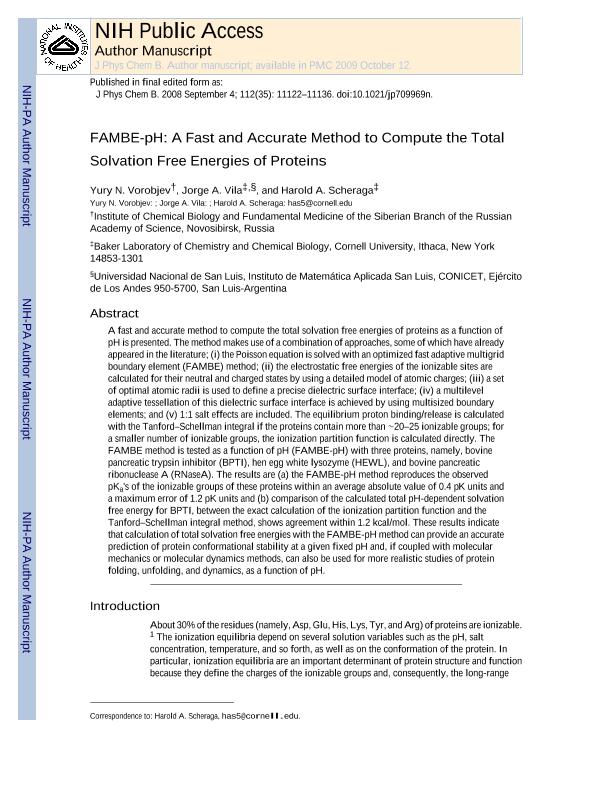Artículo
FAMBE-pH: a fast and accurate method to compute the total solvation free energies of proteins
Fecha de publicación:
12/2008
Editorial:
American Chemical Society
Revista:
Journal of Physical Chemistry B
ISSN:
1520-6106
Idioma:
Inglés
Tipo de recurso:
Artículo publicado
Clasificación temática:
Resumen
A fast and accurate method to compute the total solvation free energies of proteins as a function of pH is presented. The method makes use of a combination of approaches, some of which have already appeared in the literature; (i) the Poisson equation is solved with an optimized fast adaptive multigrid boundary element (FAMBE) method; (ii) the electrostatic free energies of the ionizable sites are calculated for their neutral and charged states by using a detailed model of atomic charges; (iii) a set of optimal atomic radii is used to define a precise dielectric surface interface; (iv) a multilevel adaptive tessellation of this dielectric surface interface is achieved by using multisized boundary elements; and (v) 1:1 salt effects are included. The equilibrium proton binding/release is calculated with the Tanford−Schellman integral if the proteins contain more than ∼20−25 ionizable groups; for a smaller number of ionizable groups, the ionization partition function is calculated directly. The FAMBE method is tested as a function of pH (FAMBE-pH) with three proteins, namely, bovine pancreatic trypsin inhibitor (BPTI), hen egg white lysozyme (HEWL), and bovine pancreatic ribonuclease A (RNaseA). The results are (a) the FAMBE-pH method reproduces the observed pKaʼs of the ionizable groups of these proteins within an average absolute value of 0.4 pK units and a maximum error of 1.2 pK units and (b) comparison of the calculated total pH-dependent solvation free energy for BPTI, between the exact calculation of the ionization partition function and the Tanford−Schellman integral method, shows agreement within 1.2 kcal/mol. These results indicate that calculation of total solvation free energies with the FAMBE-pH method can provide an accurate prediction of protein conformational stability at a given fixed pH and, if coupled with molecular mechanics or molecular dynamics methods, can also be used for more realistic studies of protein folding, unfolding, and dynamics, as a function of pH.
Palabras clave:
FREE ENERGY
,
PEPTIDES AND PROTEINS
,
ELECTRICAL PROPERTIES
,
IONIZATION
,
SOLVENTS
Archivos asociados
Licencia
Identificadores
Colecciones
Articulos(IMASL)
Articulos de INST. DE MATEMATICA APLICADA DE SAN LUIS
Articulos de INST. DE MATEMATICA APLICADA DE SAN LUIS
Citación
Vorobjev, Yury N.; Vila, Jorge Alberto; Scheraga, Harold A.; FAMBE-pH: a fast and accurate method to compute the total solvation free energies of proteins; American Chemical Society; Journal of Physical Chemistry B; 112; 35; 12-2008; 11122-11136
Compartir
Altmétricas




